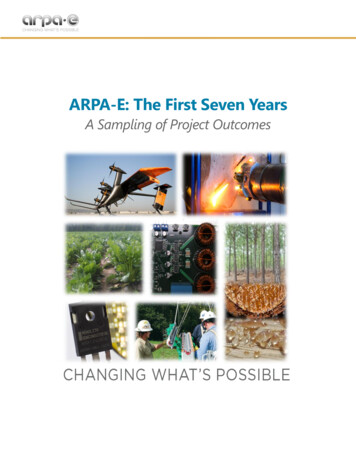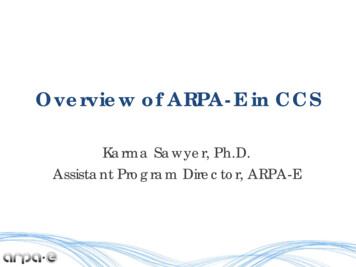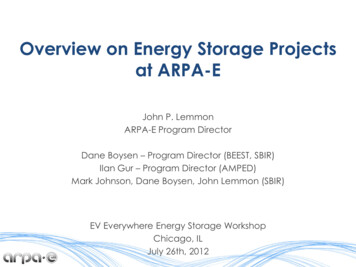
Transcription
ARPA-E: The First Seven YearsA Sampling of Project Outcomes
Dear Colleagues,In 2007, the formation of the Advanced Research Project Agency for Energy (ARPA-E) within the Department of Energywas a key recommendation of the “Rising Above the Gathering Storm Report.” The formation of the agency was quicklyauthorized, and ARPA-E began operations upon initial funding at the end of 2009. Now, after seven years of fundingtransformative R&D activities, ARPA-E has a portfolio of present and alumni project teams that are creating impact bymoving their technologies into commercial applications, or significantly advancing the technical understanding intransformative areas of energy science and engineering.There are many possible statistical measures of the success of the teams supported by ARPA-E. For instance, we canreport that since 2009 ARPA-E has provided funding of approximately 1.3 billion through 30 focused programs andthree open funding solicitations to more than 475 projects. Of those, 206 are now alumni projects. ARPA-E’s projectteams cumulatively have published 1,104 peer reviewed technical papers that have been cited 13,518 times, and havebeen awarded 101 patents. Many teams have successfully leveraged ARPA-E’s investment: 36 have started newcompanies, 60 have continued their technology development with other government support, and 45 have cumulativelyraised 1.25 billion in publically reported funding from the private sector to bring their technologies into commercialapplications.Such statistics demonstrate purposeful activity. However, the excitement and potential of these teams’ work can only betruly communicated by understanding the challenges they tackled, and what they achieved. This booklet provides a lookat selected examples of these achievements. The examples span alumni teams to teams that are just nearing the end oftheir ARPA-E project contract, with outcomes ranging from new innovations that will bear fruit in the future toinnovations that are moving into the energy sector as products today.We expect that this will be the first of many over-views of project outcomes, and their continuing development afterARPA-E support. Please distribute this to your colleagues as appropriate – we hope to encourage innovative scientistsand engineers to continue to engage us with their new ideas, and to consider joining us as Program Directors, Fellows,or Commercialization Advisors.Sincerely,Ellen D. WilliamsDirector of ARPA-EMay 17, 2016
TABLE OF CONTENTS2010-2016 Focused Programs .3Descriptions of ARPA-E’s Programs .4Grid-Scale Batteries.8Fluidic (GRIDS) – Enhanced Metal-Air Energy Storage System with Advanced Grid-Interoperable PowerElectronics Enabling Scalability and Ultra-Low Cost . 9CUNY (GRIDS) – Low-Cost Grid-Scale Electrical Storage Using a Flow-Assisted Rechargeable Zinc-ManganeseDioxide Battery . 12Harvard Flow Battery (OPEN 2012) – Small Organic Molecule Based Flow Battery . 1424M (BEEST) – Semi-Solid Rechargeable Power Sources: Flexible, High Performance Storage at UltralowCost . 16Energy Storage Systems (ESS) (GRIDS SBIR) – 25kW 200kWh Energy Storage System based on All-iron HybridFlow Battery . 19Primus (GRIDS) – Low-Cost, High Performance Flow Cells . 21UTRC (GRIDS) – Transformative Electromechanical Flow Storage System . 24Alveo (OPEN 2012) - Open Framework Electrode Batteries for Cost-Effective Stationary Storage . 26Transportation . 29Ford (AMPED) – High Precision Life Testing of Automotive Batteries and Grid Storage Batteries . 30PARC (AMPED) – Smart Embedded Network of Sensors with Optical Readout . 32Sila (SBIR) – Doubling the Energy Density Anodes of Lithium-ion Batteries for Transportation. 35FastCap (OPEN 2009) – Open Low-Cost, High Energy and Power Density, Nanotube-EnhancedUltracapacitors . 37REL (MOVE) – Fully and Intricately Conformable, Single-Piece, Mass-Manufacturable High-Pressure GasStorage Tanks . 39Onboard Dynamics (MOVE) – Vehicle-integrated Natural Gas Compressor. 41Plant Sensory Systems (OPEN 2012) – Development of High-Output, Low-Input Energy Beets . 43University of Florida (PETRO) – Producing Terpene Biofuels in Pine Trees . 46Grid Operations . 49Smart Wires (GENI) – Distributed Power Flow Control Using Smart Wires for Energy Routing . 50Varentec (GENI) – Compact Dynamic Phase Angle Regulators for Transmission Power Routing . 52Boston University (GENI) – Transmission Topology Control for Infrastructure Resilience to the Integration ofRenewable Generation . 55Autogrid (GENI) – Highly Dispatchable and Distributed Demand Response for the Integration of DistributedGeneration. 581
Power Electronics . 62APEI (ADEPT) – Low-Cost, Highly-Integrated Silicon Carbide (SiC) Multichip Power Modules (MCPMs) forEfficient Electric Vehicle Chargers . 63Transphorm (ADEPT) – High Performance GaN HEMT Modules for Agile Power Electronics . 66Cambridge Electronics/MIT (ADEPT) – Advanced Technologies for Integrated Power Electronics. 69Solarbridge Technologies (Solar ADEPT) – Scalable Submodule Power Conversion Methods for Power Density,Efficiency, Performance, and Protection Leaps in Utility-scale Photovoltaics . 72Monolith Semiconductors (SWITCHES) – Advanced Manufacturing and Performance Enhancements forReduced-cost Silicon Carbide MOSFETs . 76Soraa (OPEN 2009) – Ammonothermal Bulk GaN Crystal Growth . 79Energy Efficiency and Clean Power – Direct and Enabling Technologies . 82Makani (OPEN 2009) – Airborne Wind Turbine. 831366 (OPEN 2009) – Direct Wafer: Enabling Terawatt Photovoltaics . 85Foro (OPEN 2009) – Low-contact Drilling Technology to Enable Economical EGS Wells . 88Brookhaven/AMSC & University of Houston/SuperPower (REACT) – Superconducting Wires for Direct-DriveWind Generators . 92Stanford Radiative Cooling (OPEN 2012) – Photonic Structures for High-Efficiency Daytime RadiativeCooling . 96Harvard SLIPS (OPEN 2012) – Novel Slippery Coatings for Extreme Energy-savings . 98UHV Technologies (METALS) – Low-Cost High-Throughput In-Line XRF Scrap Metal Sorter . 101Phononic Devices (OPEN 2009) – Advanced Semiconductor Materials for High Efficiency ThermoelectricDevices . 103Infinia Technology Corporation (ITC) (BEETIT) – An Advanced Cooler with Benign Refrigerants . 106ADDENDUM: ARPA-E Challenges What’s Possible: Stationary (Grid) Energy Storage. 109For More Information . 1352
2010-2016 Focused Programs3
DESCRIPTIONS OF ARPA-E’S PROGRAMS4AcronymTitle & DescriptionYearBrief DescriptionADEPTAgile Delivery of Electric Power Technology2010Power Conversion Efficiency: Wide band-gap semiconductors forhigh-power, high-current applicationsALPHAAccelerating Low-Cost Plasma Heating andAssembly2014Fusion energy, focused on intermediate density regime, reducingthe cost of experimental tests for fusion energyAMPEDAdvanced Management and Protection ofEnergy Storage Devices2012Battery storage, primarily for EV. Addressing efficiency fromperspective of the overall battery pack with new approaches tothe battery management system. Strong DoD engagementARIDAdvanced Research in Dry-Cooling2015Developing technology to protect Power Plant efficiency underwater constraints, more efficient ‘dry-cooling’BEESTBatteries for Electric Energy Storage inTransportation2010All aspects of battery design and materials, supported a largeamount of alternative battery chemistry work (supplemented byproject awards under OPEN 2009 and 2012)BEETITBuilding Energy Efficiency ThroughInnovative Thermodevices2010Lower energy approaches to heating, ventilation and airconditioning (HVAC). Some projects funded by DoDCHARGESCycling Hardware to Analyze and ReadyGrid-Scale Electricity Storage2014Two test sites to allow Grid-scale batteries to be validated underrealistic grid operation conditionsDELTADelivering Efficient Local Thermal Amenities2014Local thermal management for comfort of individuals, goal toreduce overall AC costs by allowing less stringent building-wideACELECTROFUELSMicroorganisms for Liquid TransportationFuel2010Exploratory development of fuel productions by organisms thatdirectly use electric charge as an energy source
AcronymTitle & DescriptionYearBrief DescriptionENLITENEDEnergy-efficient Light-wave integratedTechnology Enabling Networks thatEnhance Datacenters2016Integrated photonic interconnects and novel switching networksfor more energy efficient manipulation and movement of dataFOCUSFull Spectrum Optimized Conversion andUtilization of Sunlight2014Solar energy approaches that capture both PV and thermalenergy. Approaches include spectrum splitting to differentcollectors and development of PV cells that can work at the highT of thermal collectionGENIGreen Electricity Network Integration2011Electric Power Network - Power flow controllers & software toallow more effective integration of renewablesGENSETSGenerators for Small Electrical and ThermalSystems2015Distributed Power Generation - Low-cost, small scale generatorsfor combined heat and powerGRIDSGrid Scale Rampable IntermittentDispatchable Storage2010Stationary storage, included grid-scale batteries and flowbatteries as well as other approaches such as flywheels. Batteryportfolio supplemented through OPEN 2009 and 2012 projectsGRID DATAGenerating Realistic Information for theDevelopment of Distribution andTransmission Algorithms2015Development of realistic, open-source models of transmissionand distribution grids to support advanced work on optimizationand control algorithmsHEATSHigh Energy Advanced Thermal Storage2011Thermal energy storage, including use of waste heat and storageof heat from Concentrated Solar and from Nuclear Power plantIMPACCTInnovative Materials and Process forAdvanced Carbon Capture Technologies2010Carbon Capture for emissions from coal plants.(supplemented by project awards under OPEN 2009 and 2012)IONICSIntegration and Optimization of Novel IonConducting Solids2016Improving the properties of solid ion conductors for batteries, fuelcells, and other electrochemical devices5
AcronymTitle & DescriptionYearBrief DescriptionMETALSModern Electro/Thermochemical Advancesin Light Metal Systems2013Efficient production and recycling of Al, Mg, Ti – lower cost andenergy use to support vehicle light-weightingMONITORMethane Observation Networks withInnovative Technology to ObtainReductions2014Sensing methane and localizing the leak point(s) economicallyenough for routine use by producersMOVEMethane Opportunities for Vehicular EnergyStorage tanks2012New forms of storage for natural gas that will reduce volume oftanks or allow them to be integrated into the body of the vehicleMOSAICMicro-Scale Optimized Solar-Cell Arrayswith Integrated Concentration2015Developing compact solar concentration onto high-efficiency cellswhile also maintain capture of diffuse sunlightNEXTCARNext-Generation Energy Technologies forConnected and Automated On-RoadVehiclesControl systems for enhanced use ofdistributed generation2016Vehicle and powertrain control technologies to reduce automotiveenergy use2015Developing control algorithms to create effective grid storagethrough distributed demand response, e.g. water heaters(proposals for this program are now under review)PETROPlants Engineered to Replace OilDifferent plant types to produce higherhydrocarbons2011Modification of plants to directly produce fuel-ready hydrocarbonsRANGERobust Affordable Next -Generation EnergyStorage Systems2013Battery designs that improve the overall energy density/costeffectiveness of the battery system by using safer materials (e.g.less protective packaging needed)REACTRare Earth Alternatives in CriticalTechnologies2011Materials and motor design approaches that provide options forcontinued high-efficiency in the event of rare-earth shortagesREBELSReliable Electricity Based onElectrochemical Systems2014Fuel cells designed for use in distributed power generation (downto residential scale)REFUELRenewable Energy to Fuels ThroughUtilization of Energy-Dense Liquids2016Energy dense liquid fuels from water, and CO2 and/or N2 from airpowered by renewable electricityNODES6
AcronymTitle & DescriptionYearBrief DescriptionREMOTEReducing Emissions using MethanotrophicOrganisms for Transportation Energy2013Biological conversion of methane to fuelsROOTSRhizosphere Observations OptimizingTerrestrial Sequestration2016Biofuel plant root phenotyping for improved growth propertiesand atmospheric carbon sequestrationSHIELDSingle-Pane Highly Insulating Efficient LucidDesigns2016Insulating window materials with excellent optical quality whichprevent condensation, for cost-effective retrofits or replacementsSOLAR ADEPTSolar Agile Delivery of Electrical PowerTechnology2011Improved electrical interconnects for integrating Solar Power withthe grid. Energy efficiency impactSWITCHESStrategies for Wide Bandgap, InexpensiveTransistors for Controlling High-EfficiencySystems2013Devices to improve Energy Efficiency for electric motorsTERRATransportation Energy Resources fromRenewable Agriculture2015More rapid development of sustainable biofuels crops. Sensing,robotics, informatics and genetics for advanced phenotyping ofenergy cropsTRANSNETTraveler Response Architecture using NovelSignaling for Network Efficiency inTransportation2015Control architectures and traveler incentives for energyoptimization of urban networks7
GRID-SCALE BATTERIESOverview:Advanced energy storage promises to play a key role in the modernization of our nation’s electricity grid. Currentlyrelatively little storage is deployed on the grid. However, low-cost, energy storage can not only enable the integration ofmore renewable energy on the grid, but it could also improve the grid’s operating capabilities and reliability, providebackup power during emergencies and allow deferral of infrastructure investments.Electrochemical storage (batteries) has the potential to provide flexible grid-scale storage, if enhanced performance andlower cost can be achieved. Since 2009, ARPA-E has invested significantly in R&D of potentially transformativeapproaches to create new designs, exploit known battery chemistries in new ways, and develop new battery chemistries.A diversified portfolio of new approaches has resulted, such as ARPA-E’s Grid-Scale Rampable Intermittent DispatchableStorage (GRIDS) program, which developed battery technologies that can store renewable energy for use at any locationon the grid at an investment cost less than 100 per kilowatt-hour. Another ARPA-E program Batteries for ElectricalEnergy Storage in Transportation (BEEST) developed batteries for electric vehicle (EV) and grid applications and ARPAE’s OPEN funding solicitations have also delivered new and innovative projects focused on producing grid-scale storageoptions.The most successful of all of these grid-scale battery projects have demonstrated the potential for low capital cost( 100/kWh installed at the pack level for batteries) and long cycle life, which are two major factors in energy storagecost, with performance characteristics suitable for a range of grid services, including leveling the variability in capacity.The more mature teams have already begun moving new types of storage batteries into the market, where they areproviding evidence of the performance and economic benefits needed to incentivize their rapid uptake.An example of some of the impactful projects in this field can be found below: Fluidic (GRIDS) – Enhanced Metal-Air Energy Storage System with Advanced Grid-Interoperable Power ElectronicsEnabling Scalability and Ultra-Low Cost CUNY (GRIDS) – Low-Cost Grid-Scale Electrical Storage Using a Flow-Assisted Rechargeable Zinc-ManganeseDioxide Battery Harvard Flow Battery (OPEN 2012) – Small Organic Molecule Based Flow Battery 24M (BEEST) – Semi-Solid Rechargeable Power Sources: Flexible, High Performance Storage at Ultralow Cost Energy Storage Systems (ESS) (GRIDS SBIR) – 25kW 200kWh Energy Storage System based on All-iron Hybrid FlowBattery Primus (GRIDS) – Low-Cost, High Performance Flow Cells UTRC (GRIDS) – Transformative Electromechanical Flow Storage System Alveo (OPEN 2012) - Open Framework Electrode Batteries for Cost-Effective Stationary Storage8
ZINC-AIR GRID ENERGY STORAGEUpdated: February 24, 2016PROJECT TITLES: Metal-Air Ionic Liquid Batteries;Advanced Grid-Interoperable Power Electronics Enabling Scalability And Ultra-Low CostPROGRAMS: OPEN 2009; Grid-Scale Rampable Intermittent Dispatchable Storage (GRIDS)AWARDS: 5,133,150; 2,993,128PROJECT TEAMS: Arizona State University (Lead); Fluidic Energy (Lead)PROJECT TERMS: December 2009 – June 2012; October 2010 – March 2013PRINCIPAL INVESTIGATOR (PI): Dr. Cody FriesenTECHNICAL CHALLENGEAdvanced energy storage promises to play a key role in the modernization of our nation’s electricity grid. Whilerelatively little storage is deployed on today’s grid, future grid development will likely require energy storage that notonly enables the integration of increasing amounts of renewables, but also improves the grid’s operating capabilities,enhances reliability, allows deferral of infrastructure investments and provides backup power during emergencies.Electrochemical energy storage, e.g. batteries, provide a significant opportunity to address these needs. Metal-airbatteries are particularly attractive because a key component of the battery chemistry, oxygen, is available from the airand doesn’t need to be carried in the battery cell, or recharged. However, metal-air batteries are prone to degradation,and historically have not had the ability to discharge and recharge over the large numbers of cycles required to deliverlow-cost and extended lifetime energy storage.TECHNICAL OPPORTUNITYOne major issue for metal-air batteries is that the circulating air carries away evaporating liquids from the electrolyte,degrading battery performance over time. Another issue for the desirable, low-cost Zinc-air (Zn-air) battery is that Zndendrites form on the anode as the battery is recharged, causing shorting. As a result, commercial Zn-air batterieshistorically had been limited to disposable (non-rechargeable), low power applications, such as hearing-aid batteries.Advances in materials science offered new opportunities for the design of electrodes and electrolytes that, applied tothe Zn-air battery, address the issues that prevent recharging and long lifetime operation.INNOVATION DEMONSTRATIONWith ARPA-E’s support, Arizona State University, in partnership with FluidicEnergy, explored innovative approaches to transition nonrechargeable Znair battery chemistry into a rechargeable device. They focused ondeveloping a battery design using an electrolyte based on ionic liquids.Ionic liquids are salts that are liquid at the battery operating temperature,delivering ionic conductance while maintaining substantial electricalinsulation. The team developed chemistries that have negligibleevaporation, are stable in the presence of oxygen, and do not absorb waterover the cell operating voltages, and include additives that interactfavorably with the Zn and air electrodes. In parallel they experimented withcarbon-nano-particle based air electrodes and nanostructured ZnFigure 1: Fluidic unit installed inelectrodes, the latter including 3-dimensional porous structures thatHondurasaddress the problems of formation of Zn dendrites.As the team demonstrated the ability to cycle using their Zn-air battery designs, Fluidic Energy identified pathways tocommercialization. A key issue in optimizing the battery performance was developing stringent control of operatingparameters, such as rates of charge/discharge and depth of discharge, at the level of individual cells and modules. With9
ARPA-E’s support, Fluidic Energy developed a prototype commercializable battery module, including the preliminarydevelopment of an advanced control system and integration of continuing improvements in the system of electrodesand electrolyte. Their system targeted kW-level power applications with delivery over 4 to 72 hours, requiring cost andperformance competitiveness with traditional back-up power based on diesel generators and/or lead-acid batteries.PATHWAY TO ECONOMIC IMPACTIn January 2016, Fluidic was recognized as one of the top 100 private firms positioned to solve tomorrow's global cleantechnology challenges with a 2015 Global Cleantech 100 award.Additionally, since conclusion of ARPA-E funding to the Fluidic team (in 2013), Fluidic has continued development of itscommercial product, and reported the following progress, noting that the company's Zn-air battery and basis for itscontrol system routines resulted directly from the ARPA-E-funded research projects:As of September 2015, Fluidic has raised approximately 150 million in private sector capital, including a recent equityinvestment from Caterpillar, Inc., for commercialization of the ARPA-E-funded technologies. Fluidic has established itsfirst markets in cell phone tower backup systems for developing regions, where reliable power delivery is essential.Fluidic’s integrated smart controls, which provide remote monitoring, control and diagnostics of the complete energystorage system, have been important to successful commercialization in markets outside of the U.S. The company is nowworking to transition their technology to broader rural electrification and microgrid applications. As of January 2016,Fluidic has installed more than 50,000 Zn-air battery cells, primarily in South East Asia and Latin America, reducingcustomer’s operating costs while increasing reliability. As of January 2016, Fluidic also reports that the company isentering the rural electrification market, having been selected for 500-islanded renewable microgrids by the Indonesiangovernment.Fluidic’s business model involves fabrication of the high-value components—the anode, cathode and electrolyte—in theU.S. The components are then shipped for pick-and-place assembly near the point of sale.LONG-TERM IMPACTSFluidic’s approach of leveraging its developed technology and cost position to deploy in long-duration energy storagemarkets, often in harsh environmental conditions with demanding operational requirements, has provided access to firstmarkets. The results are beginning to provide the demonstration of effective operations that are needed to open up thelong-duration storage market, which Fluidic estimates near term to be more than 25 billion. Such demonstrations areimportant for supporting entry into the conservative and more cost sensitive power grid systems in developed countriessuch as the U.S.In Fluidic’s first applications, long-duration energy storage systems demonstrate the use of grid-scale storage forreplacement of diesel generators, along with the associated CO2 emissions. The results are indicative of the types ofimprovements in reliability of grid services and reduction of greenhouse gas emissions that are possible as batteryenergy storage continues to improve in cost and performance. As an ancillary benefit, many tons of ionic liquids—chemistries developed under the ARPA-E programs—have been manufactured and deployed by Fluidic Energy; this maybe the largest commercial deployment of ionic liquids in the world, and may provide a basis for other commercialdevelopments based on these materials.INTELLECTUAL PROPERTYAs of February 2016, the Arizona State University and Fluidic Energy team’s ARPA-E funded projects have generated 11invention disclosures to ARPA-E, one pending U.S. Patent and Trademark Office patent application and eight patentsissued by the PTO:Arizona State University “Metal-Air Low Temperature Ionic Liquid Cell”. (11/25/2014) US Patent No. 8895197. Washington, DC: U.S.Patent and Trademark Office.Arizona State University “Metal-Air Cell with Performance Enhancing Additive”. (11/10/2015) US Patent No. 9184478. Washington, DC:U.S. Patent and Trademark Office.Arizona State University “Aluminum-Based Metal-Air Batteries”. (1/12/2016) US Patent No. 9236643. Washington, DC: U.S. Patent andTrademark Office.10
Fluidic, Inc. “Ionic Liquid Containing Sulfonate Ions”. (6/3/2014) US Patent No. 8741491. Washington, DC: U.S. Patent and TrademarkOffice.Fluidic, Inc. “Metal-Air Cell Comprising an Electrolyte with a Room Temperature Ionic Liquid and Hygroscopic Additive”. (8/19/2014)US Patent No. 8808929. Washington, DC: U.S. Patent and Trademark Office.Fluidic, Inc. “Degenerate Doping of Metallic Anodes”. (5/12/2015) US Patent No. 9029027. Washington, DC: U.S. Patent and TrademarkOffice.Fluidic, Inc. “Metal-Air Cell with Ion Exchange Material”. (8/25/2015) US Patent No. 9118089. Washington, DC: U.S. Patent andTrademark Office.Fluidic, Inc. “Methods of Producing Sulfate Salts of Cations from Heteroatomic Compounds and Dialkyl Sulfates and Uses Thereof”.(9/29/2015) US Patent No. 9147919. Washington, DC: U.S. Patent and Trademark Office.11
LEVERAGING ZINC MANGANESE DIOXIDE FORSTATIONARY ENERGY STORAGEUpdated: February 24, 2016PROJECT TITLE: Low-Cost Grid-Scale Electrical Storage Using a Flow-Assisted Rechargeable Zinc-Manganese DioxideBatteryPROGRAM: Grid-Scale Rampable Intermittent Dispatchable Storage (GRIDS)AWARD: 3,497,133PROJECT TEAM: City University of New York (CUNY) Energy InstitutePROJECT TERM: September 2010 – March 2015PRINCIPAL INVESTIGATOR (PI): Michael AdamsTECHNICAL CHALLENGEAdvanced energy storage promises to play a key role in modernizing our nation’s electricity grid to enable theintegration of increasing amounts of renewables, improve operating capabilities, enhance reliability, allow deferral ofinfrastructure investments, and provide backup power during emergencies. To accomplish this, storage systems areneeded that can match both the power and energy scale
4 DESCRIPTIONS OF ARPA-E'S PROGRAMSAcronym Title & Description Year Brief Description ADEPT Agile Delivery of Electric Power Technology 2010 Power Conversion Efficiency: Wide band-gap semiconductors for high-power, high-current applications ALPHA Accelerating Low-Cost Plasma Heating and Assembly 2014 Fusion energy, focused on intermediate density regime, reducing










